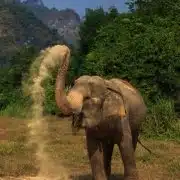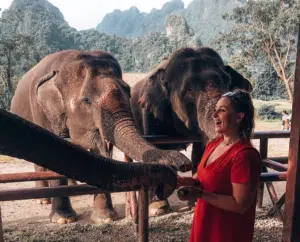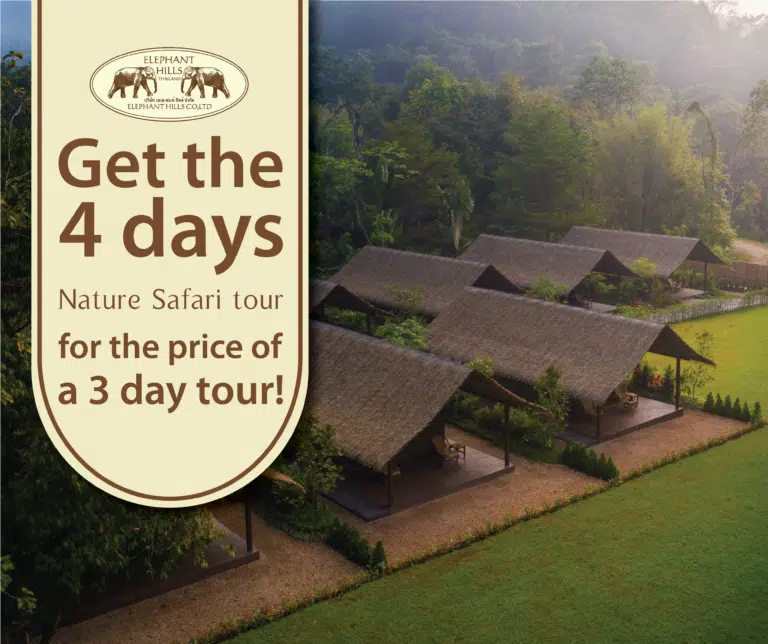Thailand’s Cultural Gems: Unveiling Temples, Traditions & Thai Cuisine
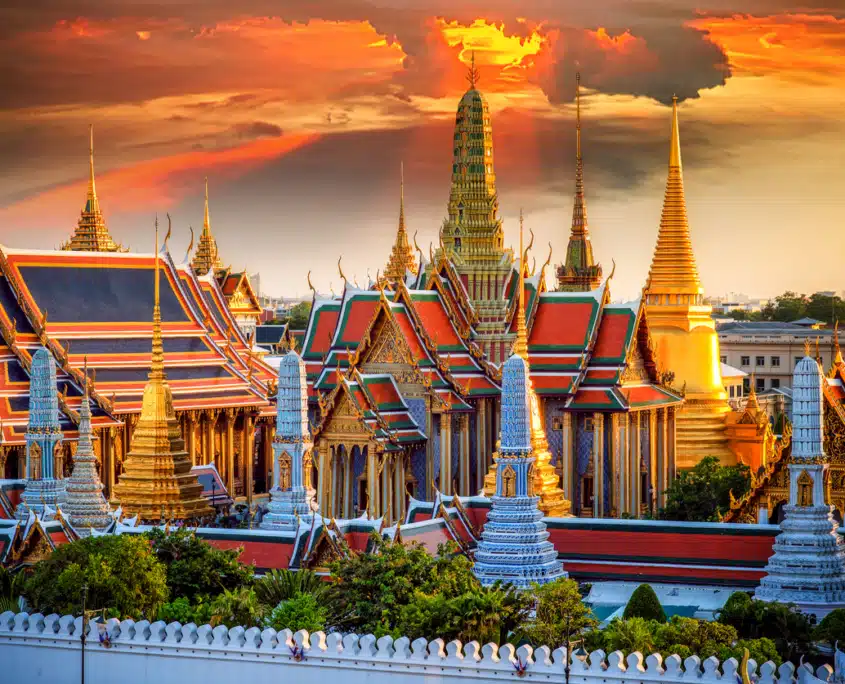
Thailand, often referred to as the ‘Land of Smiles’, is not just famed for its breathtaking landscapes but also for its rich cultural tapestry that weaves tales from ancient times to modern days. From the sacred grounds of historic temples to the rhythmic beats of traditional dances, and the aromatic allure of Thai cuisine, there’s a cultural story awaiting every traveller.
A Glimpse into Time: The History of Thailand’s Ancient Temples
Picture this: As the sun rises over the horizon, casting a golden hue over ancient stones and intricate carvings, the echoing sounds of temple bells ring in the distance. The scent of incense wafts through the air as saffron-robed monks begin their morning rituals. This isn’t just any scene; it’s a regular day in the heart of Thailand, where temples aren’t just relics of the past but pulsating centres of daily life and spiritual fulfilment.
Thailand’s temples, or ‘wats’, are much more than just photogenic spots for your next Instagram post. They’re emblematic of a journey – one that the Thai people have embarked on for centuries. These temples have borne witness to countless prayers, dreams, and hopes of generations.
But ever noticed how some temples have intricate wooden carvings while others glisten with golden spires? That’s the beauty of evolution! Over the ages, Thai temple architecture has evolved, blending various styles and influences. From the simplistic Lanna styles in the north to the grand Khmer-inspired designs in the east, every corner of Thailand tells a different story.
And speaking of stories, let’s not forget the legends. Every temple has its tale. Some speak of miracles, others of tragedies, and a few of epic romances. For instance, have you ever heard about the temple said to house a relic of Buddha’s bone? Or the one believed to grant wishes to those seeking true love?
Next time you find yourself wandering the grounds of a Thai temple, remember you’re not just treading on ancient grounds. You’re walking through tales of devotion, dreams, and a timeless culture that continues to thrive and inspire.
A Tapestry of Traditions: Thai Festivals and Celebrations
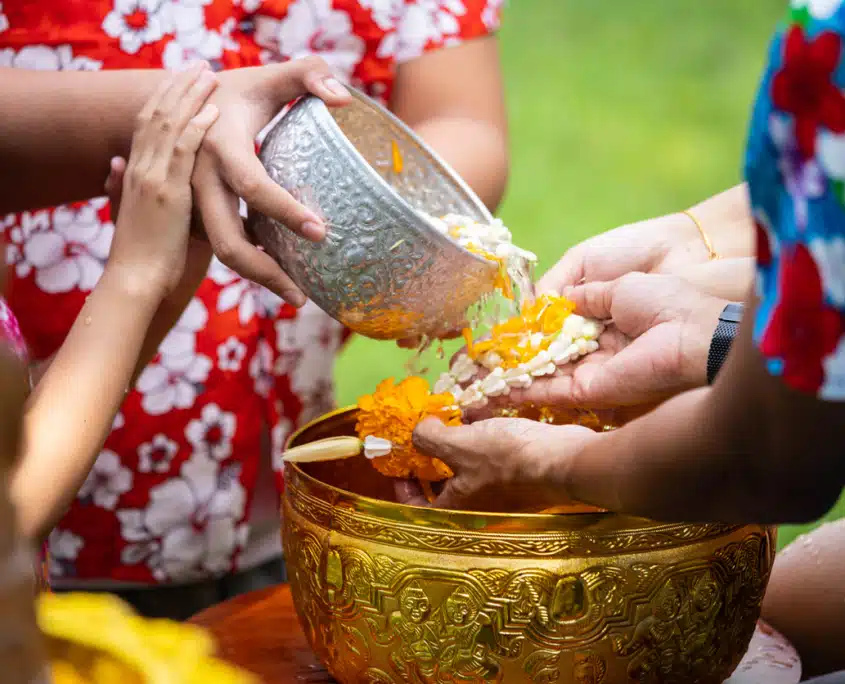
Thailand is more than its tropical beaches, bustling cities, and tantalising dishes. It’s a land bursting with vibrancy, tradition, and celebration. As the calendar months roll by, the Thai landscape transforms into a medley of colours, sounds, and festivities that encapsulate the spirit of its people and their age-old customs.
Songkran: The Water Festival
Imagine a scene where the streets are awash with water, and joyous laughter fills the air. Welcome to Songkran, Thailand’s traditional New Year celebration, occurring mid-April. Originally, it was a gentle ritual where water was poured over elders’ hands as a sign of respect. Fast forward to today, and it has transformed into an exuberant water fight! Locals and tourists alike gear up with water guns, buckets, and a sense of mischief. While the splashing is undeniably fun, the festival’s essence remains, symbolising purification and the washing away of sins and bad luck.
Loy Krathong: Festival of Lights
As the full moon bathes the November night in its glow, thousands of candlelit baskets, or ‘krathongs’, float gracefully on Thailand’s waterways. Loy Krathong, often regarded as one of the most picturesque festivals, is a time for Thais to give thanks to the goddess of water and seek forgiveness for any misdeeds. The floating krathongs, often made from banana leaves and adorned with flowers, represent letting go of grudges and negative thoughts. As they drift away, they take with them the year’s troubles, leaving hope and positivity in their wake.
Lantern Festival: A Sky Aglow
Come Yi Peng, the Northern Thai festival, and the sky transforms into a canvas of dreams. The sight of thousands of lanterns, carrying wishes and aspirations, ascending towards the heavens is nothing short of magical. Held in Chiang Mai, this festival coincides with Loy Krathong but has its distinct charm. The lanterns, ‘khom loi’, symbolise the release of misfortune and a beckoning of good luck. As they rise, they paint a mesmerising spectacle, one that remains etched in the memories of all who witness it.
Hidden Gems: The Lesser-Known Festivals
While the aforementioned festivals often steal the limelight, Thailand is home to countless local celebrations, each steeped in tradition and lore. Take, for instance, the Phi Ta Khon festival in the Dan Sai district of Loei province. A carnival where locals don vibrant masks and costumes, it’s a lively mix of dance, music, and a belief in spirits. Or the ‘Boon Bang Fai’, the Rocket Festival, an explosive event marking the start of the rainy season, where hand-made rockets soar into the skies, and communities compete for the highest launch!
Stories from the Road
Every traveller to Thailand invariably leaves with tales that breathe life into these festivals. Like Sarah, a backpacker who stumbled upon a village preparing for Loy Krathong. She recalls the kindness of a local family that invited her to craft a krathong with them, teaching her the significance of each fold and petal. Or Tom, who, during Songkran, found himself amidst a group of jubilant children, his map rendered useless by the splashes, but his heart brimming with unexpected joy.
In the tapestry of Thailand’s traditions, each thread, be it a grand festival or a humble local celebration, weaves a tale of a nation’s heart and soul, a tale that beckons travellers time and again to immerse themselves, to celebrate, and to be one with the spirit of Thailand.
The Art of Thai Craftsmanship
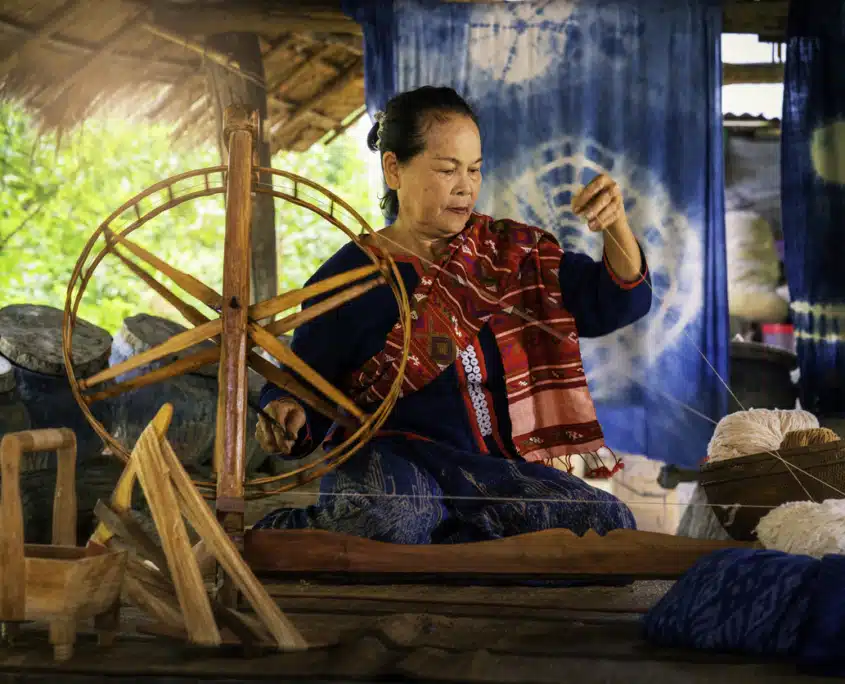
Thailand, with its rich tapestry of history and culture, is also a treasure trove of traditional arts and crafts. Each piece, be it a silk shawl, a ceramic pot, or an intricately carved mask, tells a story of centuries-old traditions, meticulous craftsmanship, and a deep-rooted love for art.
The Silken Threads of Thai Heritage
The weaving of Thai silk is an art form passed down through generations. Originating from the Northeastern region of Thailand, particularly in Isaan, silk weaving has been an integral part of the community. Each strand is meticulously hand-spun, dyed using natural ingredients, and woven on traditional looms. The result? A masterpiece that shimmers with vibrant hues, unique to each piece, capturing the essence of Thai elegance. It’s not just a fabric; it’s a narrative of patience, skill, and passion.
Pottery and Ceramics: Crafting Earth’s Essence
In the rustic villages dotted around Thailand, the age-old tradition of pottery is very much alive. The hands of local artisans transform clay into stunning vessels, each carrying the soul of the land. From the ancient Sukhothai era to modern times, Thai pottery, with its distinctive styles and glazes, has been celebrated. Particularly renowned are the Celadon wares of Chiang Mai – their jade-green glaze and crackled texture make them sought after by collectors and enthusiasts worldwide.
Masks and Puppetry: Narratives in Motion
Delving deeper into Thai culture, one discovers the enthralling world of traditional masks and puppetry. The Khon masks, essential for the classical dance-drama of the same name, are vivid representations of characters from the Ramakien epic. Handcrafted with precision, these masks are more than mere props; they are symbols of Thailand’s rich theatrical heritage. On the other hand, the Nang Yai shadow puppets, cut out from buffalo hide and painted in vibrant colours, come to life as they narrate tales of yore, casting enchanting shadows in the moonlit nights.
Thailand’s artistry is a testament to its people’s incredible skill and their unwavering dedication to preserving their heritage. Every crafted item is not just an object, but a chapter in the ongoing story of a nation that reveres its traditions, ensuring they continue to flourish in the modern age.
Thailand on a Platter: The Gastronomic Wonders of Thai Cuisine
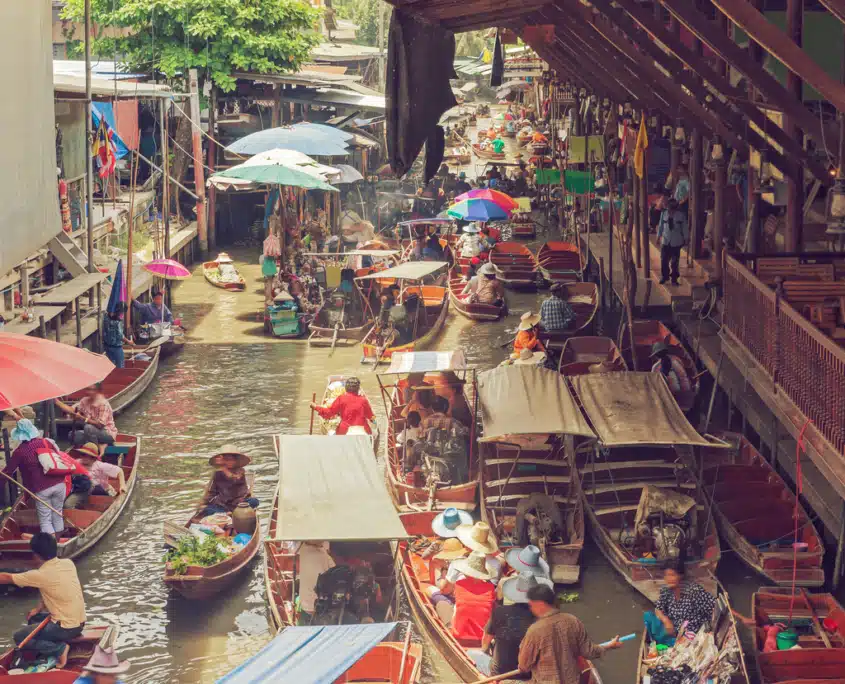
Thailand’s culinary landscape is as diverse and vibrant as its tapestry of cultures, landscapes, and traditions. A culinary journey through this Southeast Asian gem is like stepping into a world of aromatic spices, rich flavours, and age-old recipes passed down through generations.
A Rich Culinary Heritage
The roots of Thai cuisine are deep-seated in its history, influenced by its neighbours and traders from far-off lands. The ancient spice routes brought in an influx of flavours, from the fiery chillies of the Americas to the fragrant spices of India and the Middle East. But Thai chefs, with their intrinsic flair, blended these foreign influences with local produce, creating a gastronomy that is distinctly Thai. It’s a cuisine that tells tales of kingdoms, trade, and traditions, all served on a plate.
Key Ingredients: The Heart of Thai Dishes
What sets Thai cuisine apart is its harmonious blend of the five fundamental tastes: sweet, spicy, sour, salty, and umami. Central to this symphony of flavours are ingredients like lemongrass, kaffir lime leaves, galangal, and fish sauce. The fiery kick in many dishes is courtesy of the bird’s eye chilli, while coconut milk lends a creamy texture to curries and soups. Tamarind imparts a tangy touch, and the fragrant jasmine rice is the perfect accompaniment, absorbing the medley of flavours in every bite.
Regional Specialities and Culinary Tales
From the bustling streets of Bangkok to the serene landscapes of Chiang Mai, each region has its culinary jewels. In the Central Plains, one finds dishes that are a balance of the four main flavours, like the world-renowned Pad Thai. This stir-fried noodle dish, with its tangle of rice noodles, prawns, tofu, and peanuts, encapsulates the essence of Thai street food – simple, flavourful, and heartwarming.
Then there’s the spicy and aromatic Tom Yum, a hot and sour soup that’s a staple in every Thai household. With its bold combination of shrimp, mushrooms, tomatoes, and a broth infused with lemongrass and kaffir lime, it’s a dish that tantalises the taste buds and warms the soul.
From the southern region comes the beloved Green Curry. A velvety blend of green chillies, coconut milk, and a medley of vegetables or meats, it’s a testament to Thailand’s ability to turn simple ingredients into a dish that’s rich in flavour and history.
But these dishes are just the tip of the culinary iceberg. Each province, town, and even household in Thailand has its version of these classics, along with lesser-known dishes that are waiting to be discovered. Every meal is a journey, a narrative of the land’s history, and a celebration of its rich culinary heritage.
At the heart of it all, Thai cuisine is a reflection of its people’s spirit – generous, warm, and always welcoming. Whether it’s a meal in a high-end restaurant in Bangkok or a humble dish from a street-side stall, Thai food, with its burst of flavours and aromas, promises an experience that’s truly unforgettable.
The Melodious Echoes of Thai Traditional Music and Dance
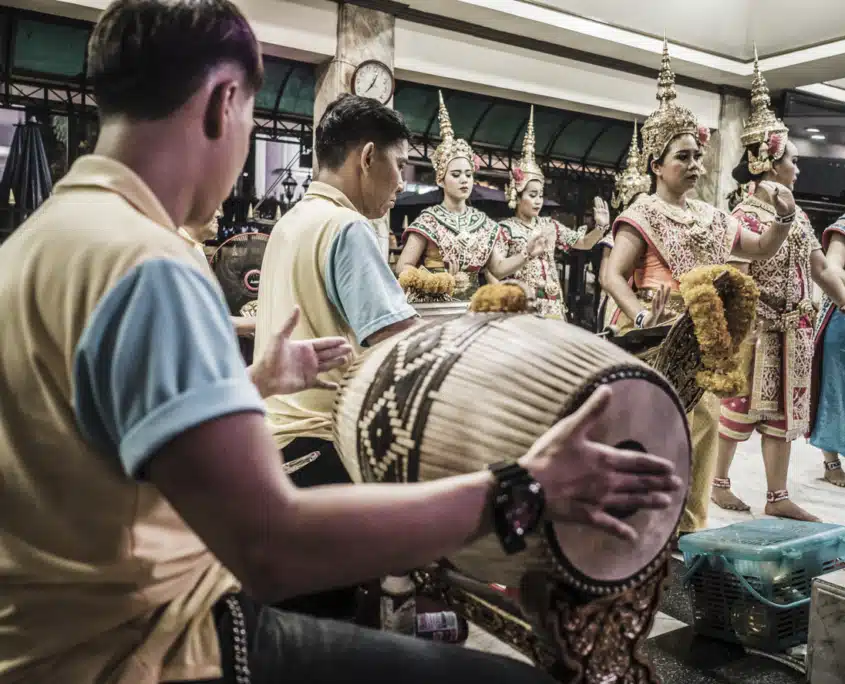
The vibrancy of Thailand is not just palpable in its landscapes and cuisine but also resonates in its traditional music and dance forms. These art forms are windows into Thailand’s rich history and cultural evolution, offering glimpses of ancient rituals, tales of gods and kings, and the everyday lives of its people.
Soulful Strains of Mor Lam and Luk Thung
Mor Lam, originating from the Northeastern Isaan region, is a distinctive form of folk music rooted in rural life. It’s not just a melody but a tale, often narrating stories of love, nature, or local events. The lead singer, or Mor Lam, is typically accompanied by instruments like the khaen, a bamboo mouth organ, and the performance is an interactive experience, engaging the audience with its lyrical improvisations.
In contrast, Luk thung, which translates to “children of the fields”, echoes the sentiments of rural Thailand but with a more modern twist. Evolving in the early 20th century, this genre juxtaposes traditional rhythms with contemporary influences. The lyrics, often poignant, reflect the hopes and struggles of the common Thai, making Luk thung an emotional journey for its listeners.
Enchanting Dance Narratives: Khon, Lakhon, and Fawn Thai
Dance in Thailand is not just a visual delight but also a narrative medium. The masked dance drama, Khon, is a testament to this. Originating from the royal courts, Khon enacts scenes from the Ramakien, the Thai version of the Indian Ramayana. The intricate masks, opulent costumes, and precise choreography transform the stage into a realm of myths, with characters like the demon king Ravana and the hero Rama coming to life.
Lakhon, on the other hand, is a more graceful and fluid dance form, often performed by female dancers. Narrating both secular and spiritual tales, Lakhon is characterised by its delicate hand movements and expressive facial gestures. The dancers, adorned in traditional attire, glide on the stage, making the stories they depict seem almost ethereal.
Fawn Thai, translating to “Thai dance”, is a genre encompassing various regional dance forms. Whether it’s the Fawn Lep (nail dance) with its emphasis on delicate finger movements or Fawn Tian (candle dance) performed with lit candles, each variant of Fawn Thai is a celebration of local customs and traditions.
Cultural Relevance and Modern Adaptations
While deeply rooted in history, Thai music and dance are not confined to the past. Contemporary artists often merge traditional forms with modern genres, creating fusion performances that appeal to both the young and old. Moreover, schools and institutions across Thailand are ensuring that these art forms are not just preserved but also evolving, introducing them to new generations in innovative ways.
Today, whether it’s a grand performance in Bangkok’s cultural centres or a local celebration in a village, the traditional music and dance of Thailand remain integral to its identity. They are not just art forms but the heartbeat of a nation, echoing its stories, dreams, and the indomitable spirit of its people.
Final Thoughts: Immersing in the Depth of Thai Culture
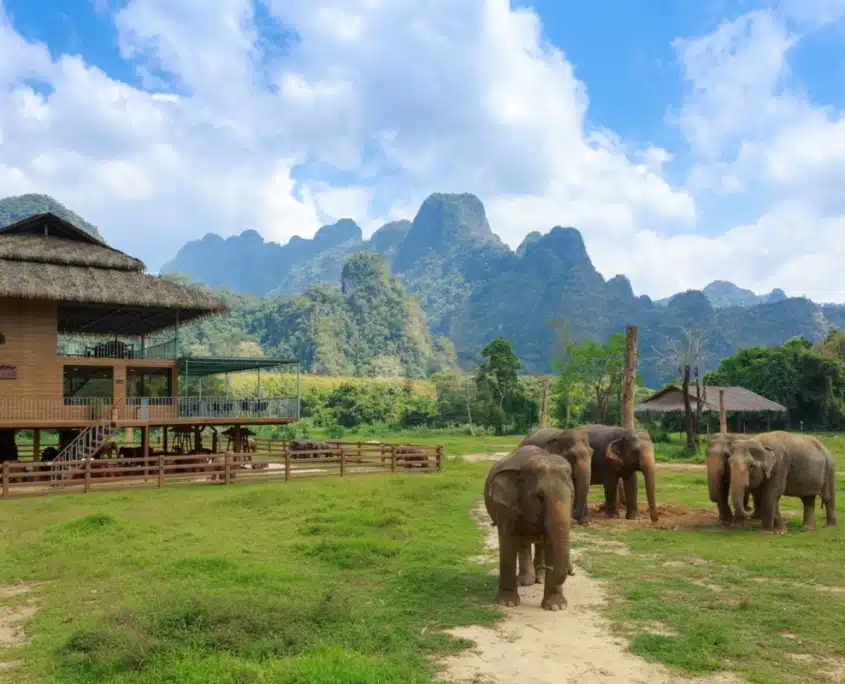
Thailand, often lauded for its pristine beaches and bustling markets, offers so much more for the discerning traveller. Beneath the surface lies a tapestry of culture, rich and diverse, woven together by centuries of history and tradition. From the soulful notes of Mor Lam echoing through the villages to the delicate dance of Lakhon performed in grand halls, the nation’s cultural heartbeat is palpable at every corner.
Each temple, each festival, and each dish tells a story. It’s a narrative of a people who, despite the relentless march of modernity, have managed to retain the essence of their ancestry. They’ve beautifully blended the old with the new, ensuring that traditions don’t just survive, but thrive in the contemporary world. And for a traveller, there’s no greater joy than uncovering these stories, feeling the rhythm of a place, and understanding its soul.
Yet, to truly appreciate the nuances of Thai culture, one needs to do more than just observe. It’s about immersion, about losing oneself in the melody of a Luk thung song or the aromatic allure of a simmering pot of Tom Yum. It’s about joining the locals during Songkran, feeling the water splash and the laughter echo. It’s about understanding that every strand of silk, every pottery piece, and every mask tells a tale.
At Elephant Hills, we understand the depth of this culture. Nestled amidst nature, our retreat offers guests a unique vantage point to not just witness but actively engage with these cultural wonders. From local performances to culinary delights, we ensure that your Thai experience is authentic, leaving you with memories and stories to cherish for a lifetime. Book an Elephant Hills tour now >>
Thailand is not just a destination; it’s a journey. A journey into the heart of a culture that’s as vibrant as its landscapes, as profound as its temples, and as warm as its people. And as you embark on this journey, let every moment, every sound, and every sight be a gentle reminder of the beauty that is Thailand.
Frequently Asked Questions about Thai Culture
- What are the main traditional dances in Thailand?
Thai traditional dances include Khon, Lakhon, Fawn Thai, and many others, each with its unique style and significance. - Why is Thai silk so renowned worldwide?
Thai silk is celebrated for its unique production process, vibrant colours, and intricate patterns, making it a sought-after textile in fashion and design. - Are there regional variations in Thai cuisine?
Yes, Thai cuisine varies by region, with dishes reflecting the ingredients and flavours abundant in each area. For instance, northern Thai food might be different from southern Thai dishes. - How do Thai festivals like Songkran and Loy Krathong differ?
Songkran is the Thai New Year celebration known for its water fights, while Loy Krathong is a festival where people release decorated baskets into water bodies to pay respects to the water spirits. - What role do temples play in Thai daily life?
Temples in Thailand are not just places of worship but also serve as community centres where people gather for festivals, ceremonies, and other cultural events.
You might also like…
Discover the Best of Southern Thailand: Your Guide to Phuket, Koh Samui, Krabi and Khao Lak
10 Best Things to Do in Phuket: The Ultimate Guide for Your Next Holiday
Discover Koh Samui: Beaches, Culture, and Island Bliss | Ultimate Travel Guide
Krabi Uncovered: Beaches, Adventure, and Natural Wonders | Definitive Travel Companion
Khao Sok National Park – A Jungle Adventure In Southern Thailand
Honeymoon Destinations in Thailand
9 Stunning Examples of Beautiful Rainforest Animals

